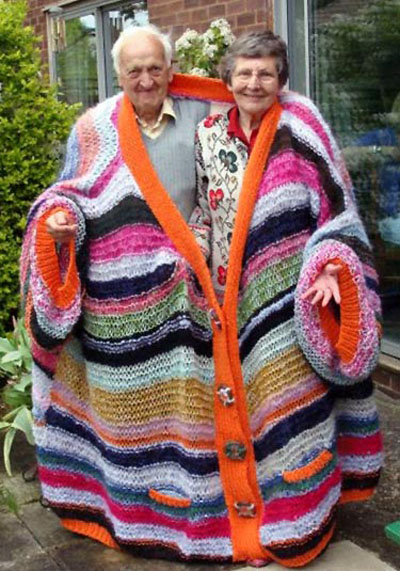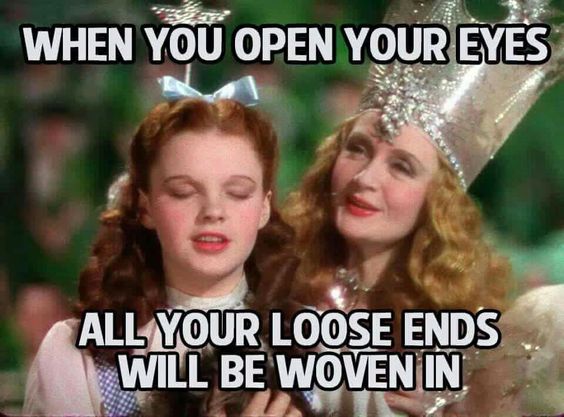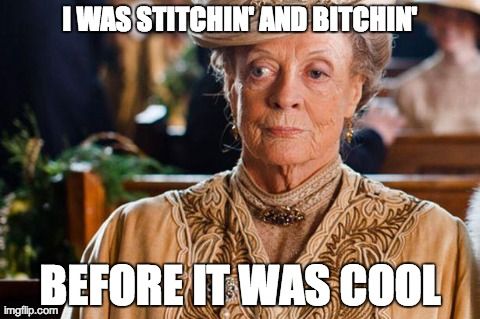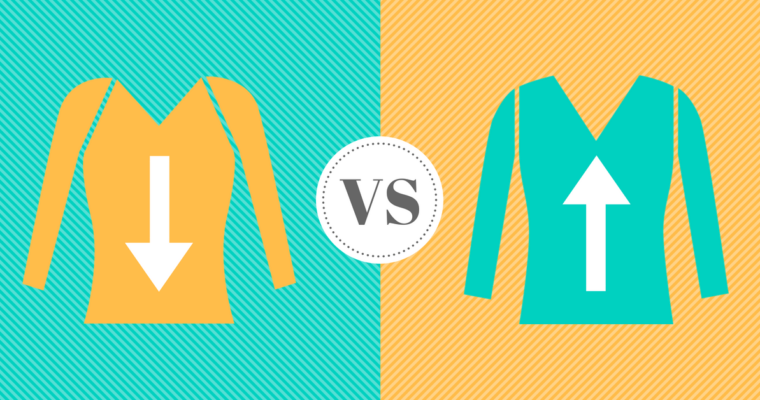There are many, many ways to knit a sweater, but there are two methods that are most common. These two construction methods are Top-Down and Bottom-Up.
Top-Down Sweaters are knit starting from the neck and working the sweater down toward the hem, usually in one piece.
Bottom-Up Sweaters are knit starting from the hem and knitting the sweater in pieces, working up to the neck.
There are advantages and disadvantages to each approach, with proponents on either side. Amy Herzog is a big fan of bottom-up sweater construction. While Karen Templar is a defender of top-down sweater construction.
But to figure out which sweater construction method is right for you we need to take a closer look at each.
To do that we’ll take a look at the following THREE F’s
- Fit
- Finishing
- Familiarity
FIT – The #1 Reason For Knitting Sweaters By Hand

Oops! Someone didn’t match gauge…
When making a sweater our biggest goal is for it to fit well.
Have ever had a dress or pants tailored? If so, you understand the difference of having a garment customized to fit you.
It’s nothing like one designed to fit as many people as possible.
In the fitted garment you look amazing.
The same goes for sweaters.
But too often we’ve only experienced store-bought sweaters that were not made to fit any one size or body type.
By making your sweater by hand, you have the ability to have a perfect fit. We’ll talk more about exactly how to do this tomorrow.
For now lets look at how top-down sweaters and bottom-up sweaters deal with customized fit.
Top-Down Fit
Sweaters made from the top have one major advantage; you can try them on as you go. This means that you can make adjustments as you knit.
Need to make the sleeves taper more? No problem!
Want to change the shape of the body? Can do!
Decided to go with a longer hem? We have the technology!
The problem with top-down sweaters is adjusting the bust. It can be difficult (or impossible) to add to the chest without making the sleeves huge.
Bottom-Up Fit
Sweaters made from the bottom up have the advantage of being knit in pieces. This means the shape of the final product is like that of a sewn project. The pieces are knit to fit the body exactly how you want it to work.
The problem with bottom-up sweaters is you have to finish the project before you can see how it fits. That means a lot of planning up front, and paying careful attention while knitting.
Because once it’s seamed up, it’s hard to go back.
Verdict: Bottom-Up will provide a better fit, but you can’t try it on until it’s finished.
FINISHING – Putting It All Together (or Not)

If only we all had a fairy godmother to help us with our finishing
Seaming seems (see what I did there?) to be a step that most crafters would rather avoid.
Yes, it takes time to seam things, but seaming also gives structure and longevity to a project.
Think about trying to pitch a tent without any tent poles.
You could hang it from something, and let it cover you like a canopy, but that’s not the most effective shelter. Your tent may not last as long.
But, it is faster. And if your goal is to get under cover as soon as possible, it’s definitely a viable option.
Top-Down Finishing
If you prefer your finishing to be minimal then top-down is the way to go.
Most top-down sweaters are knit without seams, so there is no need to sew anything together. Unless you are adding a button band or special collar, all that is needed to finish your sweater is weave in the ends.
The disadvantage here is top-down sweaters lack structure. The weight of the sweater will rest on the collar. This can lead to the sweater becoming misshapen over time because of gravity.
There are ways to mitigate this, but it’s not quite the same.
Bottom-Up Finishing
Bottom-up sweaters often need A LOT of seaming before they are finished. Since most bottom-up sweaters are knit in pieces, you must finish before knowing how it turned out.
But if everything goes well, you’ll have a fitted sweater that will last a long time.
The biggest problem with a sweater that requires seaming is the pieces often never get sewn together…
Verdict: You are more likey to wear a Top-Down sweater because it is easier to finish. But bottom-up sweaters look amazing once you finish all the seaming.
FAMILIARITY – How Comfortable Are You With Your Craft

Ok, this was a little bit of an alliteration stretch, but I couldn’t resist.
This is the biggest determining factor when choosing a sweater construction method.
If you’re starting out, your ultimate goal should be to finish your sweater. That means you want the fewest hurdles in the way.
But if you’re familiar with your craft, then getting technical to have the best fit shouldn’t be a problem.
Top-Down: This is best for beginners or first time sweater makers.
- Try on your project as you go
- Make adjustments or fix mistakes along the way
- Minimal finishing required
Bottom-Up: This is the method for you if:
- You’re confident in your ability to make fabric pieces that match
- The idea of seaming pieces together doesn’t freak you out.
Go Further With These Resources
Here are some great books to explore both Top-Down and Bottom-Up sweater construction in more depth.
Top-Down Sweater Construction Books:
Bottom-Up Sweater Construction Books:
What Next?
Now you’ve got an idea of what sweater construction you should tackle. Next we need to make sure you end up with a sweater that actually fits…
Now it’s your turn:
What sweater construction method would you choose and why? Leave a comment and let me know. I’d love to hear your thoughts.
Note: I know there are other methods, like making a sweater from side-to-side. But they aren’t common enough to use as a comparison.

I prefer top-down since you can try on as you go and there is no seaming. However, your argument for bottom-up is enticing because the seams add stability and you can change the chest measurement. I made a top-up sweater 40 years ago and I still wear it.
I generally knit my sweater from the top down. I like to try them on as I go. I am working a sweater from the bottom up right now. It is also a seamless sweater. The shoulders are joined using a 3 needle bind off. The cap sleeves are done with short row so we will see soon how this sweater fits. I am one of those knitters that tries to avoid seams as much as possible as I do not feel that my seaming skills are up to par.